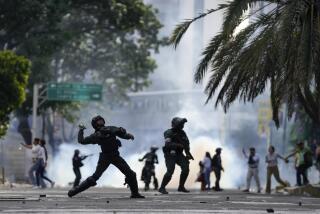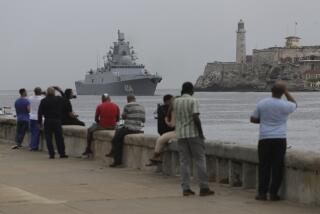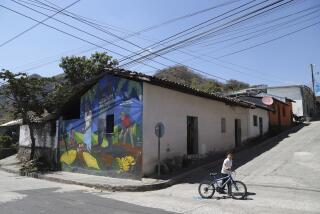THE FINAL CURTAIN : Communist Jitters in the Western Hemisphere : REGIONAL PERSPECTIVE: CARIBBEAN
MEXICO CITY â As the Soviet Union lay comatose, Fidel Castro held an extraordinary congress of his Cuban Communist Party last October and delivered a eulogy to his mentors in Moscow.
The collapse of Soviet communism, Castro declared bitterly, was âterrible, horrible, inconceivable.â Not only that, it was âthe biggest setback in the current century for Communists and revolutionaries and all the peoples of the Earth.â
For more than three decades, Castroâs Cuba was an instigator and instrument of Soviet support for insurgencies in Latin America and Africa. Without his aid and advice, there might never have been a Sandinista revolution in Nicaragua, a Marxist guerrilla threat in El Salvador, a U.S. invasion of Grenada.
And however timidly the Kremlin went along with his internationalist adventures, Castro could never have wielded such influence without massive Soviet economic and military support--backing that made Cuba, in the words of Harvard political scientist Jorge Dominguez, âa small country with a big countryâs foreign policy.â
The Soviet Union had nothing to do with Castroâs surprise guerrilla takeover of Cuba 33 years ago. But as the young dictator embraced communism, Moscow rushed to project itself into the Western Hemisphere with 20,000 troops on Cuban bases 90 miles off the Florida coast. The failed CIA-sponsored invasion of Cuba at the Bay of Pigs in 1961 cemented the Soviet connection, and Nikita S. Khrushchevâs infiltration of nuclear-armed missiles into Cuba the following year brought East-West tensions to a historic showdown with the Cuban Missile Crisis.
By the 1980s, the Soviets had built two of Latin Americaâs most powerful armies, in Cuba and in Sandinista-run Nicaragua, while propping up both Communist economies with subsidized petroleum and other assistance. Guerrillas armed with Soviet weapons, supplied directly by Cuba and Nicaragua, made war on U.S.-backed governments in El Salvador and Guatemala.
The Soviet-Cuban challenge overshadowed Washingtonâs policy in the Caribbean Basin under eight U.S. presidents. The Reagan Administration invaded Grenada to oust a Marxist government, quadrupled the might of the Salvadoran military and financed a 20,000-strong Contra insurgency to pursue one of its central obsessions--the defeat of the Sandinistas.
The Sandinistas outlasted Reagan--but barely. By 1987, Mikhail Gorbachev had made it clear to Managua that the Soviet economy was collapsing and could not sustain the war. Alarmed by the destruction wrought by superpower conflict on their region, Central American presidents led by Oscar Arias Sanchez of Costa Rica seized the initiative and called for an end to outside-sponsored insurgencies through peace talks and democratic reforms. In a historic shift, Gorbachev backed the Arias peace plan, helping force the Sandinistas in February, 1990, to hold an election they were destined to lose.
Beyond being a strategic nuisance to Washington, Sandinista Nicaragua never held much importance to the Soviet Union, which left behind little in the way of lasting economic benefit.
With the Cold Warâs passing, Central American enemies have stopped calling each other âCommunistsâ and âfascists.â After 12 years, the war in El Salvador appears headed toward a negotiated cease-fire, and peace talks are under way in Guatemala.
The spectrum of peaceful politics has expanded, enabling the defeated Sandinistas to flex their muscles as a powerful opposition party in Nicaragua and the leftist Democratic Convergence to emerge as a new civic force in El Salvador.
Sandinistas and Salvadoran guerrillas no longer call themselves Marxist-Leninists but continue to defend socialist ideals in a region governed entirely by neo-liberal free-marketeers. Both sides seem to have learned that neither the feudalistic capitalism of the past nor the Soviet-style command economy attempted by the Sandinistas can relieve the chronic poverty of Central Americaâs 30 million people.
Much of the strife that persists in the region is fueled by issues long obscured by the East-West conflict--property rights, corruption, control of state enterprises, access to political power, personal security for former combatants.
Because Central Americaâs emergence from the Cold War has been under way for more than two years, the final collapse of the Soviet Union is anticlimactic. But for Castroâs Cuba, which is almost totally dependent on Moscow for petroleum, grain and machinery, it is traumatic and destabilizing.
Even before the purge of Castroâs hard-line allies from the Kremlin after a failed coup in August, Moscow had provoked extreme economic hardships in Cuba by withdrawing generous trade subsidies. Now with Russian President Boris N. Yeltsin holding the key to Cubaâs oil supply, its prospects are even bleaker, given Castroâs image among Yeltsinâs advisers as a relic of the old Stalinist order. Yeltsin is expected to withdraw the remaining 3,000 Soviet troops in Cuba.
Without its chief benefactor, U.S. officials regard the fall of Havanaâs Communist government as inevitable. âThe system is a dinosaur in todayâs world,â says Bernard Aronson, U.S. assistant secretary of state for Western Hemisphere affairs. âWhen and how it will change you canât predict, but it will change.â
Castro has vowed to preserve Cuba as âan island of socialism in a sea of capitalism.â Having embraced Soviet communism to further his revolutionary ambitions, he made Cuba more dependent than any other country outside Eastern Europe on that systemâs survival.
Now that the system has collapsed, Cuba stands as a museum for its unwanted idols, like the busts of Lenin that still greet workers at the Caribbean islandâs fuel-starved factories.
More to Read
Sign up for Essential California
The most important California stories and recommendations in your inbox every morning.
You may occasionally receive promotional content from the Los Angeles Times.










